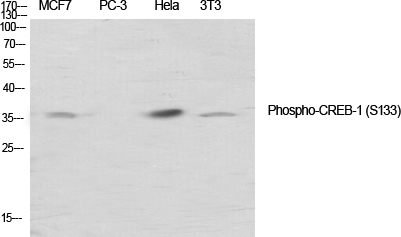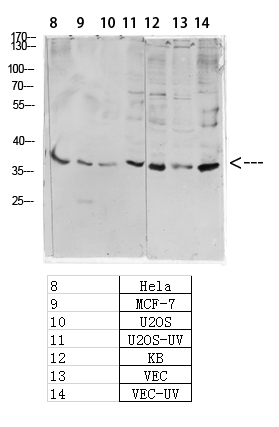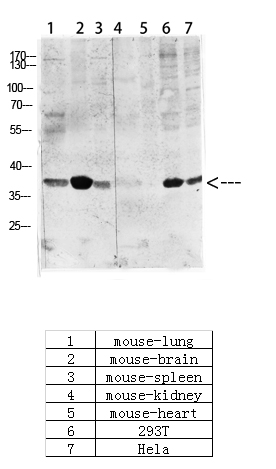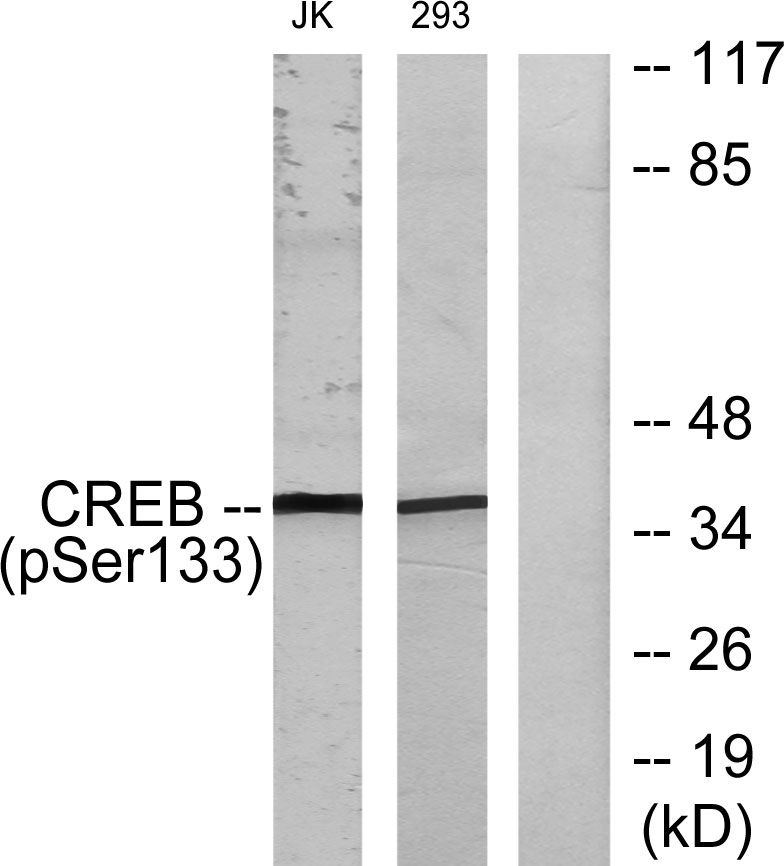CREB-1 (phospho Ser133) Polyclonal Antibody
- Catalog No.:YP0075
- Applications:IF;WB;IHC;IP;ELISA
- Reactivity:Human;Mouse;Rat;Pig
- Target:
- CREB-1
- Fields:
- >>cGMP-PKG signaling pathway;>>cAMP signaling pathway;>>PI3K-Akt signaling pathway;>>AMPK signaling pathway;>>Longevity regulating pathway;>>Adrenergic signaling in cardiomyocytes;>>Osteoclast differentiation;>>Antigen processing and presentation;>>TNF signaling pathway;>>Circadian rhythm;>>Circadian entrainment;>>Thermogenesis;>>Cholinergic synapse;>>Dopaminergic synapse;>>Insulin secretion;>>Estrogen signaling pathway;>>Melanogenesis;>>Thyroid hormone synthesis;>>Glucagon signaling pathway;>>Renin secretion;>>Aldosterone synthesis and secretion;>>Relaxin signaling pathway;>>Cortisol synthesis and secretion;>>Parathyroid hormone synthesis, secretion and action;>>Insulin resistance;>>Cushing syndrome;>>Growth hormone synthesis, secretion and action;>>Vasopressin-regulated water reabsorption;>>Huntington disease;>>Prion disease;>>Cocaine addiction;>>Amphetamine addiction;>>Alcoholism;>>Tuberculosis;>>Hepatitis B;>>Human cytomegalovirus infection;>>Human papillomavirus infection;>>Human
- Gene Name:
- CREB1
- Protein Name:
- Cyclic AMP-responsive element-binding protein 1
- Human Gene Id:
- 1385
- Human Swiss Prot No:
- P16220
- Mouse Gene Id:
- 12912
- Mouse Swiss Prot No:
- Q01147
- Rat Gene Id:
- 81646
- Rat Swiss Prot No:
- P15337
- Immunogen:
- The antiserum was produced against synthesized peptide derived from human CREB around the phosphorylation site of Ser133. AA range:100-149
- Specificity:
- Phospho-CREB-1 (S133) Polyclonal Antibody detects endogenous levels of CREB-1 protein only when phosphorylated at S133.
- Formulation:
- Liquid in PBS containing 50% glycerol, 0.5% BSA and 0.02% sodium azide.
- Source:
- Polyclonal, Rabbit,IgG
- Dilution:
- IF 1:50-200 WB 1:500 - 1:2000. IHC 1:100 - 1:300. Immunoprecipitation: 2-5 ug:mg lysate. ELISA: 1:10000. Not yet tested in other applications.
- Purification:
- The antibody was affinity-purified from rabbit antiserum by affinity-chromatography using epitope-specific immunogen.
- Concentration:
- 1 mg/ml
- Storage Stability:
- -15°C to -25°C/1 year(Do not lower than -25°C)
- Other Name:
- CREB1;Cyclic AMP-responsive element-binding protein 1;CREB-1;cAMP-responsive element-binding protein 1
- Observed Band(KD):
- 37kD
- Background:
- This gene encodes a transcription factor that is a member of the leucine zipper family of DNA binding proteins. This protein binds as a homodimer to the cAMP-responsive element, an octameric palindrome. The protein is phosphorylated by several protein kinases, and induces transcription of genes in response to hormonal stimulation of the cAMP pathway. Alternate splicing of this gene results in several transcript variants encoding different isoforms. [provided by RefSeq, Mar 2016],
- Function:
- disease:A chromosomal aberration involving CREB1 is associated with angiomatoid fibrous histiocytoma (AFH) [MIM:612160]. Translocation t(2;22)(q33;q12) with CREB1 generates a EWSR1/CREB1 fusion gene that is most common genetic abnormality in this tumor type.,function:This protein binds the cAMP response element (CRE), a sequence present in many viral and cellular promoters. CREB stimulates transcription on binding to the CRE. Transciption activation is enhanced by the TORC coactivators which act independently of Ser-133 phosphorylation. Implicated in synchronization of circadian rhythmicity.,PTM:Stimulated by phosphorylation. Phosphorylation of both Ser-133 and Ser-142 in the SCN regulates the activity of CREB and participates in circadian rhythm generation. Phosphorylation of Ser-133 allows CREBBP binding (By similarity). Phosphorylated upon DNA damage, probably by ATM or ATR.,similarit
- Subcellular Location:
- Nucleus .
- Expression:
- Eye,Placenta,Spleen,Testis,
Tuftelin 1 Facilitates Hepatocellular Carcinoma Progression through Regulation of Lipogenesis and Focal Adhesion Maturation WB,IF Human 1 : 1000, 1:100 /Huh7 cells, MHCC97H cells
Calcium/Calmodulin-Dependent Protein Kinase IV Mediates IFN-γ-Induced Immune Behaviors in Skeletal Muscle Cells. CELLULAR PHYSIOLOGY AND BIOCHEMISTRY 2018 Mar 22 WB Mouse 1:1000 brain myogenic precursor cells (MPCs), C2C12 cell
Pituitary miRNAs target GHRHR splice variants to regulate GH synthesis by mediating different intracellular signalling pathways. RNA Biology Rna Biol. 2020;17(12):1754-1766 WB Pig,Rat primary pituitary cell,GH3 cell
Cyclooxygenase-2 up-regulates hepatic somatostatin receptor 2 expression. Scientific Reports Sci Rep-Uk. 2018 Jul;8(1):1-11 WB Rat,Human cirrhotic liver L02 cell
Pirfenidone decreases mesothelioma cell proliferation and migration via inhibition of ERK and AKT and regulates mesothelioma tumor microenvironment in vivo. Scientific Reports 2018 Jul 03 WB Human JL-1 cell,H2052 cell
Fetal exposure to dichloroacetic acid and impaired cognitive function in the adulthood. Brain and Behavior Brain Behav. 2020 Oct;10(10):e01801 WB Rat 1 : 1000 Hippocampal tissue
Dichloroacetic acid-induced dysfunction in rat hippocampus and the protective effect of curcumin. METABOLIC BRAIN DISEASE Metab Brain Dis. 2021 Apr;36(4):545-556 WB Rat 1:800 Hippocampus
β2-microglobulin has a different regulatory molecular mechanism between ER + and ER − breast cancer with HER2 −. BMC CANCER Bmc Cancer. 2019 Dec;19(1):1-11 IHC Human 1:150 breast cancer tissue
Developmental Exposure to Atrazine Impairs Spatial Memory and Downregulates the Hippocampal D1 Dopamine Receptor and cAMP-Dependent Signaling Pathway in Rats. INTERNATIONAL JOURNAL OF MOLECULAR SCIENCES Int J Mol Sci. 2018 Aug;19(8):2241 WB Rat 1:1000 hippocampal tissue
miR-709 inhibits GHRP6 induced GH synthesis by targeting PRKCA in pituitary. MOLECULAR AND CELLULAR ENDOCRINOLOGY Mol Cell Endocrinol. 2020 Apr;506:110763 WB Rat GH3 cell
Tanshinone IIA Improves Depression-like Behavior in Mice by Activating the ERK-CREB-BDNF Signaling Pathway. NEUROSCIENCE Neuroscience. 2020 Mar;430:1 WB Mouse brain
- June 19-2018
- WESTERN IMMUNOBLOTTING PROTOCOL
- June 19-2018
- IMMUNOHISTOCHEMISTRY-PARAFFIN PROTOCOL
- June 19-2018
- IMMUNOFLUORESCENCE PROTOCOL
- September 08-2020
- FLOW-CYTOMEYRT-PROTOCOL
- May 20-2022
- Cell-Based ELISA│解您多样本WB检测之困扰
- July 13-2018
- CELL-BASED-ELISA-PROTOCOL-FOR-ACETYL-PROTEIN
- July 13-2018
- CELL-BASED-ELISA-PROTOCOL-FOR-PHOSPHO-PROTEIN
- July 13-2018
- Antibody-FAQs
- Products Images
.png)
- Wang, Yue, et al. "Fetal exposure to dichloroacetic acid and impaired cognitive function in the adulthood." Brain and Behavior 10.10 (2020): e01801.

- Chai, Dandan, et al. "β2-microglobulin has a different regulatory molecular mechanism between ER+ and ER− breast cancer with HER2−." BMC cancer 19.1 (2019): 223.

- Immunofluorescence analysis of Hela cell. 1,CREB-1 (phospho Ser133) Polyclonal Antibody(red) was diluted at 1:200(4° overnight). β-Tubulin Monoclonal Antibody(5G3)(green) was diluted at 1:200(4° overnight). 2, Goat Anti Rabbit Alexa Fluor 594 Catalog:RS3611 was diluted at 1:1000(room temperature, 50min). Goat Anti Mouse Alexa Fluor 488 Catalog:RS3208 was diluted at 1:1000(room temperature, 50min).
-if-47.jpg)
- Immunofluorescence analysis of mouse-testis tissue. 1,CREB-1 (phospho Ser133) Polyclonal Antibody(red) was diluted at 1:200(4°C,overnight). 2, Cy3 labled Secondary antibody was diluted at 1:300(room temperature, 50min).3, Picture B: DAPI(blue) 10min. Picture A:Target. Picture B: DAPI. Picture C: merge of A+B
-if-48.jpg)
- Immunofluorescence analysis of mouse-testis tissue. 1,CREB-1 (phospho Ser133) Polyclonal Antibody(red) was diluted at 1:200(4°C,overnight). 2, Cy3 labled Secondary antibody was diluted at 1:300(room temperature, 50min).3, Picture B: DAPI(blue) 10min. Picture A:Target. Picture B: DAPI. Picture C: merge of A+B
-if-49.jpg)
- Immunofluorescence analysis of mouse-lung tissue. 1,CREB-1 (phospho Ser133) Polyclonal Antibody(red) was diluted at 1:200(4°C,overnight). 2, Cy3 labled Secondary antibody was diluted at 1:300(room temperature, 50min).3, Picture B: DAPI(blue) 10min. Picture A:Target. Picture B: DAPI. Picture C: merge of A+B
-if-50.jpg)
- Immunofluorescence analysis of mouse-lung tissue. 1,CREB-1 (phospho Ser133) Polyclonal Antibody(red) was diluted at 1:200(4°C,overnight). 2, Cy3 labled Secondary antibody was diluted at 1:300(room temperature, 50min).3, Picture B: DAPI(blue) 10min. Picture A:Target. Picture B: DAPI. Picture C: merge of A+B
42745.jpg)
- Western Blot analysis of various cells using primary antibody diluted at 1:1000(4°C overnight). Secondary antibody:Goat Anti-rabbit IgG IRDye 800( diluted at 1:5000, 25°C, 1 hour). Cell lysate was extracted by Minute™ Plasma Membrane Protein Isolation and Cell Fractionation Kit(SM-005, Inventbiotech,MN,USA).
poly-ihc-human-uterus.jpg)
- Immunohistochemical analysis of paraffin-embedded Human-uterus tissue. 1,CREB-1 (phospho Ser133) Polyclonal Antibody was diluted at 1:200(4°C,overnight). 2, Sodium citrate pH 6.0 was used for antibody retrieval(>98°C,20min). 3,Secondary antibody was diluted at 1:200(room tempeRature, 30min). Negative control was used by secondary antibody only.
poly-ihc-human-uterus-cancer.jpg)
- Immunohistochemical analysis of paraffin-embedded Human-uterus-cancer tissue. 1,CREB-1 (phospho Ser133) Polyclonal Antibody was diluted at 1:200(4°C,overnight). 2, Sodium citrate pH 6.0 was used for antibody retrieval(>98°C,20min). 3,Secondary antibody was diluted at 1:200(room tempeRature, 30min). Negative control was used by secondary antibody only.
poly-ihc-human-tonsil.jpg)
- Immunohistochemical analysis of paraffin-embedded Human-Tonsil tissue. 1,CREB-1 (phospho Ser133) Polyclonal Antibody was diluted at 1:200(4°C,overnight). 2, Sodium citrate pH 6.0 was used for antibody retrieval(>98°C,20min). 3,Secondary antibody was diluted at 1:200(room tempeRature, 30min). Negative control was used by secondary antibody only.
poly-ihc-human-colon-cancer.jpg)
- Immunohistochemical analysis of paraffin-embedded Human-colon-cancer tissue. 1,CREB-1 (phospho Ser133) Polyclonal Antibody was diluted at 1:200(4°C,overnight). 2, Sodium citrate pH 6.0 was used for antibody retrieval(>98°C,20min). 3,Secondary antibody was diluted at 1:200(room tempeRature, 30min). Negative control was used by secondary antibody only.
poly-ihc-human-liver-cancer.jpg)
- Immunohistochemical analysis of paraffin-embedded Human-liver-cancer tissue. 1,CREB-1 (phospho Ser133) Polyclonal Antibody was diluted at 1:200(4°C,overnight). 2, Sodium citrate pH 6.0 was used for antibody retrieval(>98°C,20min). 3,Secondary antibody was diluted at 1:200(room tempeRature, 30min). Negative control was used by secondary antibody only.
poly-ihc-human-stomach-cancer.jpg)
- Immunohistochemical analysis of paraffin-embedded Human-stomach-cancer tissue. 1,CREB-1 (phospho Ser133) Polyclonal Antibody was diluted at 1:200(4°C,overnight). 2, Sodium citrate pH 6.0 was used for antibody retrieval(>98°C,20min). 3,Secondary antibody was diluted at 1:200(room tempeRature, 30min). Negative control was used by secondary antibody only.
poly-ihc-rat-testis.jpg)
- Immunohistochemical analysis of paraffin-embedded Rat-testis tissue. 1,CREB-1 (phospho Ser133) Polyclonal Antibody was diluted at 1:200(4°C,overnight). 2, Sodium citrate pH 6.0 was used for antibody retrieval(>98°C,20min). 3,Secondary antibody was diluted at 1:200(room tempeRature, 30min). Negative control was used by secondary antibody only.
poly-ihc-rat-lung.jpg)
- Immunohistochemical analysis of paraffin-embedded Rat-lung tissue. 1,CREB-1 (phospho Ser133) Polyclonal Antibody was diluted at 1:200(4°C,overnight). 2, Sodium citrate pH 6.0 was used for antibody retrieval(>98°C,20min). 3,Secondary antibody was diluted at 1:200(room tempeRature, 30min). Negative control was used by secondary antibody only.
poly-ihc-rat-spinal-cord.jpg)
- Immunohistochemical analysis of paraffin-embedded Rat-spinal-cord tissue. 1,CREB-1 (phospho Ser133) Polyclonal Antibody was diluted at 1:200(4°C,overnight). 2, Sodium citrate pH 6.0 was used for antibody retrieval(>98°C,20min). 3,Secondary antibody was diluted at 1:200(room tempeRature, 30min). Negative control was used by secondary antibody only.
poly-ihc-mouse-heart.jpg)
- Immunohistochemical analysis of paraffin-embedded Mouse-heart tissue. 1,CREB-1 (phospho Ser133) Polyclonal Antibody was diluted at 1:200(4°C,overnight). 2, Sodium citrate pH 6.0 was used for antibody retrieval(>98°C,20min). 3,Secondary antibody was diluted at 1:200(room tempeRature, 30min). Negative control was used by secondary antibody only.
poly-ihc-mouse-liver.jpg)
- Immunohistochemical analysis of paraffin-embedded Mouse-liver tissue. 1,CREB-1 (phospho Ser133) Polyclonal Antibody was diluted at 1:200(4°C,overnight). 2, Sodium citrate pH 6.0 was used for antibody retrieval(>98°C,20min). 3,Secondary antibody was diluted at 1:200(room tempeRature, 30min). Negative control was used by secondary antibody only.
poly-ihc-mouse-lung.jpg)
- Immunohistochemical analysis of paraffin-embedded Mouse-lung tissue. 1,CREB-1 (phospho Ser133) Polyclonal Antibody was diluted at 1:200(4°C,overnight). 2, Sodium citrate pH 6.0 was used for antibody retrieval(>98°C,20min). 3,Secondary antibody was diluted at 1:200(room tempeRature, 30min). Negative control was used by secondary antibody only.
poly-ihc-mouse-kidney.jpg)
- Immunohistochemical analysis of paraffin-embedded Mouse-kidney tissue. 1,CREB-1 (phospho Ser133) Polyclonal Antibody was diluted at 1:200(4°C,overnight). 2, Sodium citrate pH 6.0 was used for antibody retrieval(>98°C,20min). 3,Secondary antibody was diluted at 1:200(room tempeRature, 30min). Negative control was used by secondary antibody only.
poly-ihc-mouse-spleen.jpg)
- Immunohistochemical analysis of paraffin-embedded Mouse-spleen tissue. 1,CREB-1 (phospho Ser133) Polyclonal Antibody was diluted at 1:200(4°C,overnight). 2, Sodium citrate pH 6.0 was used for antibody retrieval(>98°C,20min). 3,Secondary antibody was diluted at 1:200(room tempeRature, 30min). Negative control was used by secondary antibody only.

- Western Blot analysis of various cells using Phospho-CREB-1 (S133) Polyclonal Antibody diluted at 1:2000
.jpg)
- Western Blot analysis of HELA cells using Phospho-CREB-1 (S133) Polyclonal Antibody diluted at 1:2000

- Western Blot analysis of various cells using Antibody diluted at 1:1000. Secondary antibody(catalog#:RS0002) was diluted at 1:20000

- Western Blot analysis of various cells using Antibody diluted at 1:1000. Secondary antibody(catalog#:RS0002) was diluted at 1:20000

- Immunohistochemistry analysis of paraffin-embedded human breast carcinoma, using CREB (Phospho-Ser133) Antibody. The picture on the right is blocked with the phospho peptide.

- Western blot analysis of lysates from Jurkat and 293 cells treated with UV, using CREB (Phospho-Ser133) Antibody. The lane on the right is blocked with the phospho peptide.



